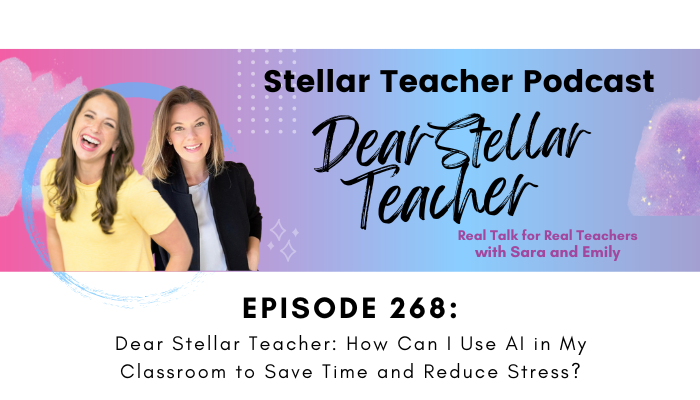
Click play below to listen to practical ways to use AI in your classroom to save time and reduce stress.
In this episode of Dear Stellar Teacher, Emily and I talk about how using AI can actually make teaching easier and why it doesn’t have to feel overwhelming. We break down practical ways to use AI for things like organizing student groups, creating seating charts, planning parent-teacher conferences, and streamlining your day—without losing the human touch that makes teaching meaningful.
We share the lessons we’ve learned from experimenting with AI, including how to give it context, assign roles, and get back useful results that actually save time. We also discuss common pitfalls and how to make sure AI works for you. Whether you’re just curious about AI or ready to start using it in your classroom tomorrow, this episode is full of tips and ideas you can put into action immediately.
By the end of the episode, you’ll have a clear picture of how AI can be a powerful helper in your teaching toolkit, without replacing the things that only a teacher can do. Tune in for a friendly, informative conversation that’s packed with strategies to save time, reduce stress, and help your classroom run smoother than ever.
Do you have a burning question you want us to explore on the podcast? Or maybe you have an amazing story that deserves a shout-out? We’d be thrilled to feature your question or stellar story on the show! Simply fill out this form. We can’t wait to hear from you!
In this episode on AI in the classroom, we share:
- Practical, actionable tips for incorporating AI that you can try in your classroom tomorrow
- How to use AI to streamline planning and organize your day
- Tips for creating seating charts and grouping students efficiently
- Ways to plan parent-teacher conferences faster and smarter
- Strategies for giving AI the right context to get useful results
- Common pitfalls teachers encounter with AI and how to avoid them
- Ideas for keeping your teaching human while using AI as a helper
Some links on this page are affiliate links, which means we may earn a small commission when you make a purchase. No extra cost to you—just a little way to support our work!
Resources:
- Great Big Beautiful Life by Emily Henry
- Dare I Say It by Naomi Watts
- Join The Stellar Literacy Collective
- Fill out the Dear Stellar Teacher form for a chance to be featured on a future episode.
- Sign up for my Private Podcast: Confident Writer Systems Series
- Sign up for my FREE Revision Made Easy email series
- If you’re enjoying this podcast, please leave a review on Apple Podcasts!
Related Episodes and Blog Posts:
- Episode 260, Dear Stellar Teacher: Our Phonics and Intervention Confessions (and What We’d Do Differently!)
- Episode 251, Dear Stellar Teacher: Our Writing Confessions (and What We’d Do Differently!)
- Episode 238, Dear Stellar Teacher: How Can I Reach My Goals Without Feeling Overwhelmed?
- Episode 234, Dear Stellar Teacher: What’s the best way to teach comprehension strategies and skills?
Connect with me:
- Join my newsletter
- Shop my TPT store here
- Subscribe to our YouTube channel
- Instagram: @thestellarteachercompany
- Facebook: The Stellar Teacher Company
More About Stellar Teacher Podcast:
Welcome to the Stellar Teacher Podcast! We believe teaching literacy is a skill. It takes a lot of time, practice, and effort to be good at it. This podcast will show you how to level up your literacy instruction and make a massive impact on your students, all while having a little fun!
Your host, Sara Marye, is a literacy specialist passionate about helping elementary teachers around the world pass on their love of reading to their students. She has over a decade of experience working as a classroom teacher and school administrator. Sara has made it her mission to create high-quality, no-fluff resources and lesson ideas that are both meaningful and engaging for young readers.
Each week, Sara and her guests will share their knowledge, tips, and tricks so that you can feel confident in your ability to transform your students into life-long readers.
Tune in on your favorite podcast platform: Apple, Google, Amazon, Spotify, Castbox, and more! If you’re loving this podcast, please rate, review, and follow!
Podcast (stellar-teacher-podcast): Play in new window | Download
Sara
Hey, stellar teachers, welcome back to another episode. We are starting off another month, which means I am joined by my co-host Emily for another episode of Dear Stellar Teacher. Emily, I always love it when you get to join me on the show. Welcome! How are you doing?
Emily
Hey, Sara! I’m doing really well. I’m excited about today’s episode. We have a really fun topic to talk about today, so this should be fun.
Sara
I know. So, spoiler alert: we’re going to talk all about artificial intelligence. AI has not helped us with this episode at all, which I kind of feel like it maybe should have. I didn’t use AI to prepare for this—maybe you did, I don’t know—but we’re going to talk all about how teachers can use AI in the classroom. Before we do that, what are you reading lately? Finished any good books? Did you abandon any not-so-good books?
Emily
I finally got to read Emily Henry’s new book, Great Big Beautiful Life.
Sara
What did you think?
Emily
I liked it a lot! I gave it five stars. I love historical fiction, and I hate to admit it, but I also love romance, just because it’s easy, breezy, with no super complicated storylines. So, it was kind of like the marriage of both of my favorite genres. I really, really liked it. Did you get to finish that one too?
Sara
Yeah, I finished that one. I forget when, but I really liked it too. I felt like it had a different Emily Henry vibe, but I really liked it. I mean, I love everything she does, and I enjoyed the romance elements more than the historical fiction aspects. I thought it was a great book.
Emily
Really? That’s funny, because I was the opposite. I was like, I just want to hear about— I can’t even remember the character’s name now—but I just wanted to hear about her life.
Sara
When they got to the point where they were talking about the sister in the cult, I was like, that’s where I wanted to know more. But yeah, the whole book was great.
Emily
Yeah, it really was. So definitely recommend that one. What about you? What have you been reading recently?
Sara
I’ve been on a nonfiction kick this year, which is kind of fun. I’m a little bit like, okay, I need some fiction now—I may be getting a little burnt out on nonfiction. But I recently finished Naomi Watts’s book, Dare I Say It, which is all about everything she wished she knew about menopause before going through it. And as someone in their mid-40s, I’m experiencing all of the joys of perimenopause. It’s like, if you know, you know—and if you don’t know, you will know. But I loved her book because I’ve read a bunch of different books on menopause, and hers just felt really empowering. Like, we don’t have to view aging as a bad thing. You can still be strong, confident, beautiful, and successful, even if your body feels like it’s falling apart. It was just a really empowering book to read. So for anyone in their mid-40s dealing with some unfortunate hormone symptoms, check out her book—I found it really encouraging. Emily, you can add that to your list of things to read in like a decade.
Emily
That’s awesome that you read that book and that you’re talking about it because I feel like that’s one of those topics people don’t typically discuss. Then you start to go through experiences, like I just experienced with pregnancy, and you don’t even know what’s normal and what’s not because people don’t talk about all the stuff.
Sara
Always happy to talk about it and recommend books because I feel like I’ve read them all.
Sara
Okay, so let’s talk about artificial intelligence. I know when I was in the classroom, AI—I mean, neither of us experienced AI back then—but we use it quite a bit in Stellar Teacher, whether it’s reviewing content or helping generate ideas. I think it’s such a great tool, and there are so many ways teachers could be using it. If you’re a teacher who hasn’t started using AI yet, we want to share some ideas about how we would have used it if we were still in the classroom. So, what are some of the things you’ve come up with?
Emily
Okay, so let me start off by saying, if the ideas that we share aren’t exactly applicable for you, I’m really hoping this episode just gets your brain going on how you could use AI to work out systems and things like that in your classroom. It doesn’t just have to be for checking emails or things like that, but hopefully some of these ideas can help you think of more ways that AI can help in your classroom.
So my first idea is to use AI to sort student groups. I thought this was a really cool idea because I remember looking at my data when I taught. We used DIBELS, so I could see myself taking that information, putting it in AI, and then saying, “Create four groups” or “five groups.” The other cool thing you can do when I taught small groups is, you know, you have paraprofessionals coming in, this student being pulled for speech services, that student being pulled for XYZ. You can put those conditions in and say, “Create groups. Here’s my timeframe, but this student is going to be gone at this time,” and the AI can do the legwork for you to create not only your groups but also your schedule.
Sara
Yeah, I love the idea of using it to create groups because I remember spending so much time looking at not only DIBELS but also our beginning-of-year assessment and our guided reading levels, trying to analyze multiple data sources to figure out groups. You can upload all of those documents into various AI platforms, and they can do the analysis for you. Quick little disclaimer: do not upload student information to AI—like first and last names. You don’t want that on there, so either use first names only, initials, or student numbers. We don’t want to give AI private student information, but you can still really utilize the analysis features to form those groups for you.
Kind of along those same lines, an idea someone on our team shared—and I was like, this would have been brilliant and so helpful—is using AI to create your seating chart. How many times have you thought, “Okay, this student can’t be next to that student. I need groups of four, or I have rows, or whatever it is”? You can give AI all of that information—whether you’re using ChatGPT or something else—tell it what you’re looking for, whether it’s groups of four or five, two girls and two boys in each group, students who need to be separated, or even which groups should be closest to the board or furthest away from each other. It can do all of that for you. So if you’re struggling to figure out your seating chart, put that information into ChatGPT, school AI, or another AI tool and see what it comes up with.
Emily
Yeah, that’s a really good idea. Not only for table groups, but also for field trip groups—you know, “I need this student to be with this student” or “I need this student not to be with that student.” Lunch groups, partners, or any group project—you can have ChatGPT create those groups, and it would be a fair way to generate them. I just love the idea of taking out some of these tasks that we spent so much mental energy on and letting AI do it in a snap.
Sara
…and save your mental energy for things that are more important.
Emily
Yeah. Speaking of mental energy, something we use AI or ChatGPT a lot for is just checking images for accuracy, typos, clarity—things like that. So if you send home flyers or posts for families, it’s a great idea to have ChatGPT check them. I always use ChatGPT as the generic AI term—it’s my go-to. You can upload images and say, “Check this for clarity. Check this for typos.” It makes you look so much more professional because we can all think of a time we sent something home with the wrong day or a terrible typo.
Sara
I am still that person who makes so many mistakes. I can’t tell you the number of emails or flyers I sent home to parents. It’s funny because the parents would never reply to the important emails, but they would reply like, “Oh, your email has a typo.”
Emily
Yeah, I’m glad you read it—with a magnifying glass too.
Sara
Yeah, exactly. I love the idea of using it as your spot checker. I never had enough time to actually review what I was sending home, so AI can serve as a second set of eyes.
Kind of along those same lines, I love using this personally and professionally: using AI to rewrite an email with a specific tone. If you have a parent you need to be more direct with, or a little softer with, or maybe you want to send a really harsh email but know it would burn bridges—you write the harsh email, give it to ChatGPT, and say, “Make this friendlier. Make this softer.” On the flip side, if you have a hard time delivering tough news, like letting parents know exactly where their student is, you write a soft, friendly email, put it into ChatGPT, and say, “Make this more direct. Make this more firm.” You can write whatever you want, and AI can support you by adjusting the tone to fit your needs or audience.
Emily
I love that idea of adjusting the tone because sometimes it’s just so hard for us to be direct when you’re not naturally a direct person. That can feel uncomfortable, but sometimes it’s so needed. So it’s definitely a great way to do that, whether you’re writing parent emails or communicating with coworkers—maybe you need to tell a coworker something, or your principal—and it can give you an idea of how to approach the situation. As I said, we have a couple of little tips.
One of my tips is to think of AI as a first draft. When I started using that mindset, it really helped me because we don’t want to just put something into ChatGPT, copy and paste it, and send it. You really want to spend the time reviewing it, making sure it sounds like a human wrote it. As we’re using AI, we’re getting used to the results and starting to be able to really tell. I recommend having the mindset that this is my first draft, and I will adjust it from here. That has really, really helped me—adding your own tone of voice, your own personality, and reading word for word. Do I mean everything that is written here? Do I mean this? Just adding your personality can take AI and elevate it to the next level, making it so much more personable.
Sara
Yeah, I think it’s really important to realize that we never want to copy and paste exactly what AI gives us. It’s such a great brainstorming partner or reviewer, like all the examples we’ve shared. But take it and, of course, don’t assume that’s the final draft—revise it to make it work for you.
Emily
Exactly. Another great use for AI is for parent-teacher conferences. We’ve already talked about wording for hard conversations, but you can also use it to create outlines for conferences. I think that would be super helpful so you know you’re hitting on everything you want to cover prior to your conference. Plus, it will make you look super prepared and professional, and you’ll be sure that you’re addressing everything you need to address. I love that idea too.
Sara
Yeah, I think using it—especially anytime you want to add a little extra professional polish to whatever you’re doing—AI can help you do that pretty quickly.
One area where it can be really helpful is classroom management. I used to do different call-and-response activities with my students—like I would say a word and they would respond with a phrase, or I would clap and they would clap a certain number of times. But all those call-and-response ideas get old after a while, and students get tired of them. ChatGPT can give you a ton of different ideas. You can tell it, “Hey, I’m a fourth-grade teacher and I want to make some call-and-response activities. This is what I’ve used in the past. Can you give me some additional options we can use?” It’s such a simple thing you can easily do.
Similarly, I love using ChatGPT to help brainstorm behavior strategies. If you have a student you’re struggling with, you can type or speak your concerns and ask, “What classroom management strategy could I try?” You could even tell it what you’ve already tried and see what it comes up with. The way it works is it combs the internet for anything related to that topic. It can see blog posts, articles, and other resources. So especially for classroom management, it can be a great tool to help you come up with ideas you might not have considered yet.
Emily
Is that how it works?
Sara
I mean, I don’t know exactly how it works. Honestly, I know it doesn’t just generate its own knowledge. It uses knowledge that already exists on the internet. But yeah, I don’t know the specifics.
Emily
Yeah, as it’s getting more sophisticated, you’re right—it does reach for different sources on the internet. But that being said, ChatGPT specifically—because that’s what we use—makes mistakes. So going back to what I mentioned before, you have got to review it. Please, please, I’m begging you: do not just take its word for everything. Treat it like a first draft.
Sara
Yeah, I was gonna say, with that being said, let’s maybe share some of the things we’ve learned about how to utilize AI in an effective way. I remember when I first started using it, I would be like, “Write this email for me,” and give it absolutely no context about what it was. A couple of things I’ve learned about using AI more effectively are: first, let it know what you want it to be. Assign it a role. For example, “You are a fourth-grade classroom teacher who is getting ready for parent-teacher conferences,” or whatever the context is, so it knows the specific role.
Another thing I’ve found really helpful is that the more information you give it, the better the output will be. If you have the app on your phone, you can speak to it, which is faster than typing. You can just do a big word dump of what you’re looking for. For lengthier tasks, before I have it do the work, I ask, “Do you have any questions for me that will help you be more successful in this task?” It often asks clarifying questions, which are also really helpful for me to think about. That really helps it get all the information it needs from me so it can produce a much higher-quality result than it would have otherwise.
Emily
Okay, I definitely agree with you on assigning it a role. Tell it who you want it to be and the perspective you want it to take. But I have to say, when it asks me clarifying questions, it drives me nuts. I’m like, “I literally just told you, just write it!” It’s asking clarifying questions, and I’m like, please just write it.
Sara
But the clarifying questions, at least for me—I don’t know what questions it’s asking you—are usually really helpful.
Emily
Okay, another great tactic when using ChatGPT is to keep it all on one thread. If you use one thread, or if you create different threads for different projects or specific tasks, it gathers that information and learns how you want it to respond. That’s super helpful because you don’t have to go through the same steps over and over again. One thread remembers your context. This ties back to storing information. It does store information, so like Sara said before, we want to be careful about what we put in it, especially student information. But it’s helpful because then you don’t have to tell it repeatedly, “I’m a fourth-grade teacher addressing a parent,” things like that. You can also organize threads into folders, which is super helpful.
Sara
Yeah, in general, hopefully this episode gives you some new ways and ideas for how to utilize AI in your classroom. Here’s my take: I was a little reluctant at first. I thought, “No, I am not going to embrace this; I don’t like the idea of it.” But the reality is, it’s here, it’s not going anywhere, and it’s going to influence education in some way. Our students are going to know how to use it. So if you haven’t started using AI yet, give it a try. Try some of the things we shared in this episode just to get started. The sooner you learn to use it in really helpful ways, the easier it will be to adjust when it becomes the norm. Everyone’s job is going to be impacted by AI at some point, so the sooner you learn, the easier it is.
Emily
Yeah, we can definitely use it to our advantage—to save time and reduce the mental gymnastics, like we were talking about. But ultimately, AI is not replacing teachers. We’re always going to be teachers. Nobody knows your students like you do, and you are the best thing for your students. At the same time, you can have AI as a tool in your tool belt to be more efficient and free up time for the important things.
Sara
Absolutely. The human connection piece is always going to be needed, and it will always be incredibly important in education. Teachers aren’t going anywhere. But if we have a tool that can help with the mundane tasks that drain our energy, we’ll have so much more time and energy for the connection piece, which is so important.
Emily
Exactly. Well said.
Sara
Okay, well, if you have other AI tips, suggestions, or strategies, let us know so we can share them with teachers in our audience. We hope you’re having a great start to the school year, and Emily, I’ll see you back here next month.
Emily
See you soon. Bye.

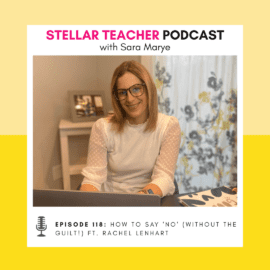

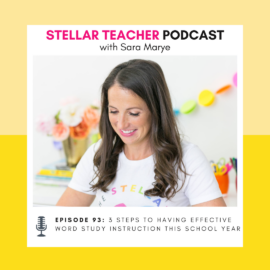
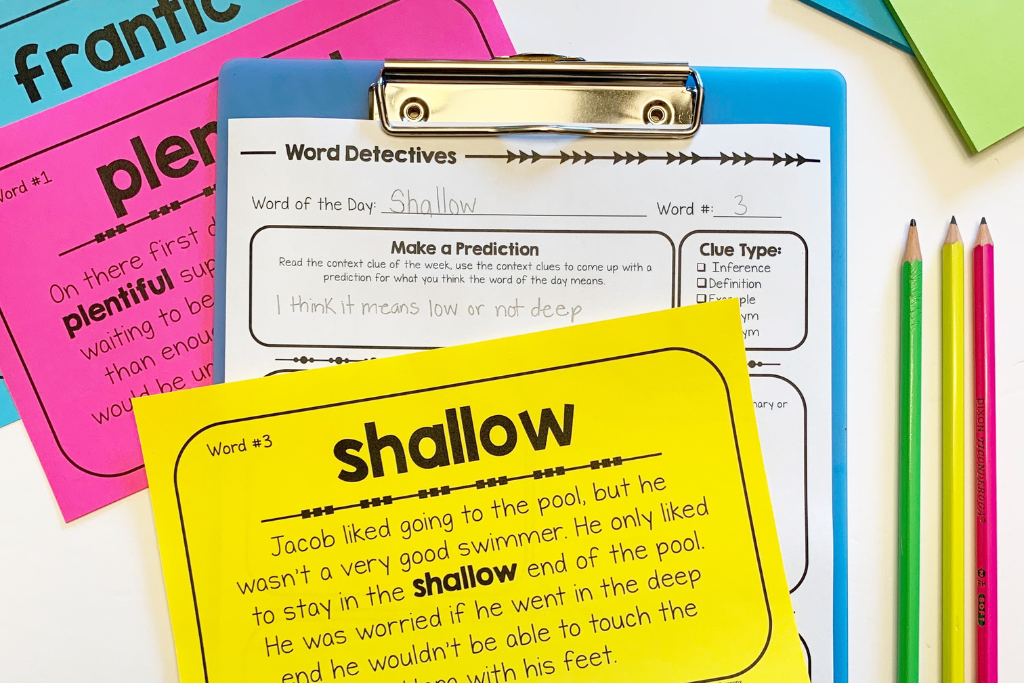

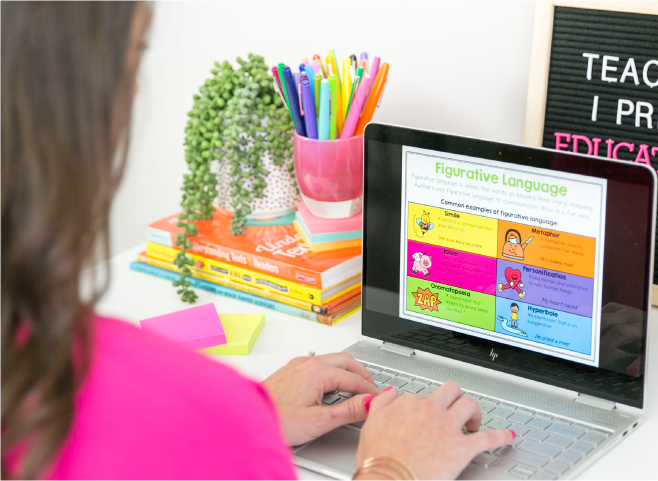
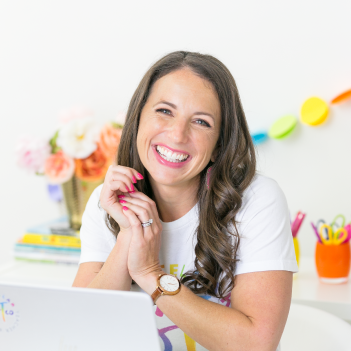
Leave a Comment
You must be logged in to post a comment.